

Writing Systems (Lecture 4) Syllabary. Types[edit] A writing system using a syllabary is complete when it covers all syllables in the corresponding spoken language without requiring complex orthographic / graphemic rules, like implicit codas (〈C1V〉 ⇒ /C1VC2/) silent vowels (〈C1V1+C2V2〉 ⇒ /C1V1C2/) or echo vowels (〈C1V1+C2V1〉 ⇒ /C1V1C2/).

This loosely corresponds to shallow orthographies in alphabetic writing systems. True syllabograms are those that encompass all parts of a syllable, i.e. initial onset, medial nucleus and final coda, but since onset and coda are optional in at least some languages, there are middle (nucleus), start (onset-nucleus), end (nucleus-coda) and full (onset-nucleus-coda) true syllabograms. Most syllabaries only feature one or two kinds of syllabograms and form other syllables by graphemic rules. Languages using syllabaries[edit] Syllabaries often begin as simplified logograms, as shown here with the Japanese katakana writing system. Difference from abugidas[edit] Comparison to English alphabet[edit] Cherokee syllabary.
The Cherokee syllabary is a syllabary invented by Sequoyah to write the Cherokee language in the late 1810s and early 1820s.
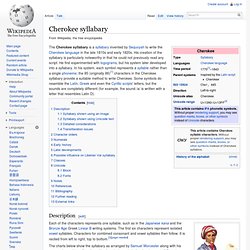
His creation of the syllabary is particularly noteworthy in that he could not previously read any script. He first experimented with logograms, but his system later developed into a syllabary. Vai syllabary. The greater part of the modern Vai syllabary. Eh and oh are the open vowels [ɛ, ɔ]. The jg on the bottom row is [ŋɡ]. Not shown are syllables beginning with g, h, w, m, n, ny, ng [ŋ], and vowels. Structure of the script[edit] Braille. Braille /ˈbreɪl/[a] is a tactile writing system used by the blind and the visually impaired.
It is traditionally written with embossed paper. Braille-users can read computer screens and other electronic supports thanks to refreshable braille displays. They can write braille with the original slate and stylus or type it on a braille writer, such as a portable braille note-taker, or on a computer that prints with a braille embosser. Braille is named after its creator, Frenchman Louis Braille, who went blind following a childhood accident. Rebus. A German rebus, circa 1620.
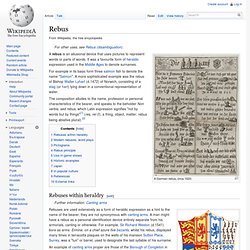
A rebus is an allusional device that uses pictures to represent words or parts of words. It was a favourite form of heraldic expression used in the Middle Ages to denote surnames. The composition alludes to the name, profession or personal characteristics of the bearer, and speaks to the beholder Non verbis, sed rebus, which Latin expression signifies "not by words but by things"[1] (res, rei (f), a thing, object, matter; rebus being ablative plural).[2] Rebuses within heraldry[edit] Modern rebuses, word plays[edit] A modern example of the rebus used as a form of word play is: Cuneiform script. Writing system. Writing systems of the world today.

Code of Hammurabi. The Code of Hammurabi is a well-preserved Babylonian law code of ancient Iraq, formerly Mesopotamia, dating back to about 1772 BC.

It is one of the oldest deciphered writings of significant length in the world. The sixth Babylonian king, Hammurabi, enacted the code, and partial copies exist on a human-sized stone stele and various clay tablets. Klingon writing systems. Klingon alphabets are fictional alphabets used in the Star Trek movies and television shows to write the Klingon language.
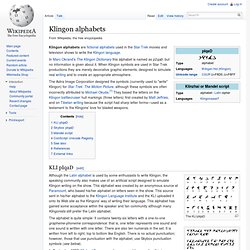
In Marc Okrand's The Klingon Dictionary this alphabet is named as pIqaD, but no information is given about it. When Klingon symbols are used in Star Trek productions they are merely decorative graphic elements, designed to simulate real writing and to create an appropriate atmosphere. The Astra Image Corporation designed the symbols (currently used to "write" Klingon) for Star Trek: The Motion Picture, although these symbols are often incorrectly attributed to Michael Okuda.[1] They based the letters on the Klingon battlecruiser hull markings (three letters) first created by Matt Jeffries, and on Tibetan writing because the script had sharp letter forms—used as a testament to the Klingons' love for bladed weapons. KLI pIqaD[edit] Epic of Gilgamesh. The Epic of Gilgamesh, an epic poem from Mesopotamia, is considered the world's first truly great work of literature.
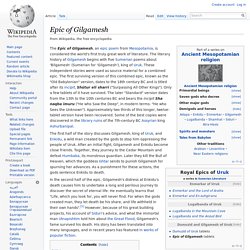
The literary history of Gilgamesh begins with five Sumerian poems about 'Bilgamesh' (Sumerian for 'Gilgamesh'), king of Uruk. These independent stories were used as source material for a combined epic. The first surviving version of this combined epic, known as the "Old Babylonian" version, dates to the 18th century BC and is titled after its incipit, Shūtur eli sharrī ("Surpassing All Other Kings"). Only a few tablets of it have survived. The later "Standard" version dates from the 13th to the 10th centuries BC and bears the incipit Sha naqba īmuru ("He who Saw the Deep", in modern terms: "He who Sees the Unknown"). Logogram. Logograms are commonly known also as "ideograms". Strictly speaking, however, ideograms represent ideas directly rather than words and morphemes, and none of the logographic systems described here is truly ideographic.
Since logograms are visual symbols representing words rather than the sounds or phonemes that make up the word, it is relatively easier to remember or guess the meaning of logograms, while it might be relatively harder to remember or guess the sound of alphabetic written words. Another feature of logograms is that a single logogram may be used by a plurality of languages to represent words with similar meanings. Alexander Marshack. Archaeology career[edit] Despite lacking a PhD, Marshack became a research associate at the Peabody Museum of Archaeology and Ethnology at Harvard University in 1963 with the support of Hallam L.

Movius, giving him access to state and university archaeological collections that he would not otherwise have been able to view.[1] He rose to public prominence after the publication of The Roots of Civilization in 1972, where he proposed the controversial theory that notches and lines carved on certain Upper Paleolithic bone plaques were in fact notation systems, specifically lunar calendars notating the passage of time.[2] Using microscopic analysis, Marshack showed that seemingly random or meaningless notches on bone were sometimes interpretable as structured series of numbers. Following a stroke in 2003, his health was in decline, and he died in December 2004. References[edit] Jump up ^ Times Online (2005-01-22). External links[edit] Writing Systems. A writing system as a set of visible or tactile signs used to represent units of language in a systematic way.
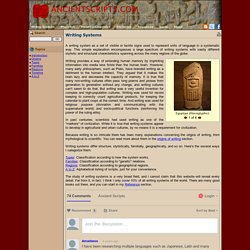
This simple explanation encompasses a large spectrum of writing systems with vastly different stylistic and structural characteristics spanning across the many regions of the globe. Pictogram. A pictogram, also called a pictogramme, pictograph, or simply picto,[1] and also an 'icon', is an ideogram that conveys its meaning through its pictorial resemblance to a physical object.
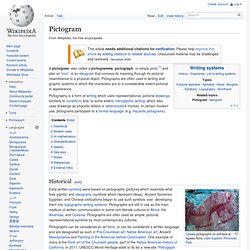
Pictographs are often used in writing and graphic systems in which the characters are to a considerable extent pictorial in appearance. Pictography is a form of writing which uses representational, pictorial drawings, similarly to cuneiform and, to some extent, hieroglyphic writing, which also uses drawings as phonetic letters or determinative rhymes. In certain modern use, pictograms participate to a formal language (e.g. Hazards pictograms). Historical[edit] Early written symbols were based on pictographs (pictures which resemble what they signify) and ideograms (symbols which represent ideas).
Omniglot - the guide to languages, alphabets and other writing systems. Symbolic Counting Tokens from the Early Near East. These are samples of the clay counters used in the Near East from about 9,000 B.C. (calibrated) to 1500 B.C. There were about 500 distinct types, although not in all times and places. Tokens start to be found at widely separated sites as of 8,000 B.C. (C-14), such as Level III of Tell Mureybet in Syria and Level E of Ganj Dareh in western Iran. Tokens were used at sites throughout the Near East, from Israel to Syria, Turkey, Iraq, and Iran, with the exception of Central Anatolia. Sumerian Calculation. Big Thinkers.
History of Information (Lecture 1) Geoffrey Nunberg. Geoffrey Nunberg (born June 1, 1945) is an American linguist and an adjunct professor at the UC Berkeley School of Information. Nunberg has taught at Stanford University and served as a principal scientist at the Xerox Palo Alto Research Center from the mid-1980s to 2000. Advocates and faith[edit] Nicholas G. Carr. Nicholas G. Carr (born 1959) is an American writer who has published books and articles on technology, business, and culture. 'The Shallows': This Is Your Brain Online. Technology Determinism (Lecture 2) The Cult of the Amateur. The book was based in part on a controversial essay Keen wrote for The Weekly Standard, criticizing Web 2.0 for being similar to Marxism, for destroying professionalism and for making it impossible to find high quality material amidst all of the user-generated web content.[1][2][3] Contents[edit]
The Search: How Google and Its Rivals Rewrote the Rules of Business and Transformed Our Culture (9781591840886): John Battelle. The Shock of the Old. Alvin Toffler. Alvin Toffler (born October 4, 1928) is an American writer and futurist, known for his works discussing the digital revolution, communication revolution and technological singularity. The Third Wave (book) Guns, Germs, and Steel.